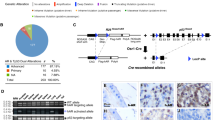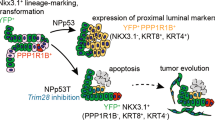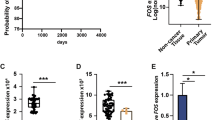Abstract
ApoJ/Clusterin (CLU) is a heterodimeric protein localized in the nucleus, cytoplasm or secretory organelles and involved in cell survival and neoplastic transformation. Its function in human cancer is still highly controversial. In this study, we examined the prostate of mice in which CLU has been genetically inactivated. Surprisingly, we observed transformation of the prostate epithelium in the majority of CLU knockout mice. Either PIN (prostate intraepithelial neoplasia) or differentiated carcinoma was observed in 100 and 87% of mice with homozygous or heterozygous deletion of CLU, respectively. Crossing CLU knockout with TRAMP (prostate cancer prone) mice results in a strong enhancement of metastatic spread. Finally, CLU depletion causes tumourigenesis in female TRAMP mice, which are normally cancer free. Mechanistically, deletion of CLU induces activation of nuclear factor-kB, a potentially oncogenic transcription factor important for the proliferation and survival of prostate cells.
This is a preview of subscription content, access via your institution
Access options
Subscribe to this journal
Receive 50 print issues and online access
$259.00 per year
only $5.18 per issue
Buy this article
- Purchase on Springer Link
- Instant access to full article PDF
Prices may be subject to local taxes which are calculated during checkout







Similar content being viewed by others
References
Bettuzzi S, Hiipakka RA, Gilna P, Liao ST . (1989). Identification of an androgen-repressed mRNA in rat ventral prostate as coding for sulphated glycoprotein 2 by cDNA cloning and sequence analysis. Biochem J 257: 293–296.
Caccamo AE, Scaltriti M, Caporali A, D’Arca D, Corti A, Corvetta D et al. (2005). Ca2+ depletion induces nuclear clusterin, a novel effector of apoptosis in immortalized human prostate cells. Cell Death Differ 12: 101–104.
Caccamo AE, Scaltriti M, Caporali A, D’Arca D, Scorcioni F, Candiano G et al. (2003). Nuclear translocation of a clusterin isoform is associated with induction of anoikis in SV40-immortalized human prostate epithelial cells. Ann NY Acad Sci 1010: 514–519.
Caporali A, Davalli P, Astancolle S, D’Arca D, Brausi M, Bettuzzi S et al. (2004). The chemopreventive action of catechins in the TRAMP mouse model of prostate carcinogenesis is accompanied by clusterin over-expression. Carcinogenesis 25: 2217–2224.
Chayka O, Corvetta D, Dews M, Caccamo AE, Piotrowska I, Santilli G et al. (2009). Clusterin, a haploinsufficient tumor suppressor gene in neuroblastomas. J Natl Cancer Inst 101: 663–677.
Chen CD, Sawyers CL . (2002). NF-kappa B activates prostate-specific antigen expression and is upregulated in androgen-independent prostate cancer. Mol Cell Biol 22: 2862–2870.
Chen T, Turner J, McCarthy S, Scaltriti M, Bettuzzi S, Yeatman TJ . (2004). Clusterin-mediated apoptosis is regulated by adenomatous polyposis coli and is p21 dependent but p53 independent. Cancer Res 64: 7412–7419.
Chiaverotti T, Couto SS, Donjacour A, Mao JH, Nagase H, Cardiff RD et al. (2008). Dissociation of epithelial and neuroendocrine carcinoma lineages in the transgenic adenocarcinoma of mouse prostate model of prostate cancer. Am J Pathol 172: 236–246.
Cussenot O, Berthon P, Berger R, Mowszowicz I, Faille A, Hojman F et al. (1991). Immortalization of human adult normal prostatic epithelial cells by liposomes containing large T-SV40 gene. J Urol 146: 881–886.
Fritz IB, Burdzy K, Setchell B, Blaschuk O . (1983). Ram rete testis fluid contains a protein (clusterin) which influences cell-cell interactions in vitro. Biol Reprod 28: 1173–1188.
Gleave M, Miyake H . (2005). Use of antisense oligonucleotides targeting the cytoprotective gene, clusterin, to enhance androgen- and chemo-sensitivity in prostate cancer. World J Urol 23: 38–46.
Greenberg NM, DeMayo F, Finegold MJ, Medina D, Tilley WD, Aspinall JO et al. (1995). Prostate cancer in a transgenic mouse. Proc Natl Acad Sci USA 92: 3439–3443.
Hellebrekers DM, Melotte V, Vire E, Langenkamp E, Molema G, Fuks F et al. (2007). Identification of epigenetically silenced genes in tumor endothelial cells. Cancer Res 67: 4138–4148.
Ito K, Bernardi R, Morotti A, Matsuoka S, Saglio G, Ikeda Y et al. (2008). PML targeting eradicates quiescent leukaemia-initiating cells. Nature 453: 1072–1078.
Jones SE, Jomary C . (2002). Clusterin. Int J Biochem Cell Biol 34: 427–431.
July LV, Akbari M, Zellweger T, Jones EC, Goldenberg SL, Gleave ME . (2002). Clusterin expression is significantly enhanced in prostate cancer cells following androgen withdrawal therapy. Prostate 50: 179–188.
Kaplan-Lefko PJ, Chen TM, Ittmann MM, Barrios RJ, Ayala GE, Huss WJ et al. (2003). Pathobiology of autochthonous prostate cancer in a pre-clinical transgenic mouse model. Prostate 55: 219–237.
Lau SH, Sham JS, Xie D, Tzang CH, Tang D, Ma N et al. (2006). Clusterin plays an important role in hepatocellular carcinoma metastasis. Oncogene 25: 1242–1250.
McLaughlin L, Zhu G, Mistry M, Ley-Ebert C, Stuart WD, Florio CJ et al. (2000). Apolipoprotein J/clusterin limits the severity of murine autoimmune myocarditis. J Clin Invest 106: 1105–1113.
Miyake H, Muramaki M, Kurahashi T, Yamanaka K, Hara I, Gleave M et al. (2006). Expression of clusterin in prostate cancer correlates with Gleason score but not with prognosis in patients undergoing radical prostatectomy without neoadjuvant hormonal therapy. Urology 68: 609–614.
Miyake H, Nelson C, Rennie PS, Gleave ME . (2000). Testosterone-repressed prostate message-2 is an antiapoptotic gene involved in progression to androgen independence in prostate cancer. Cancer Res 60: 170–176.
Morris EJ, Ji JY, Yang F, Di Stefano L, Herr A, Moon NS et al. (2008). E2F1 represses beta-catenin transcription and is antagonized by both pRB and CDK8. Nature 455: 552–556.
Nizard P, Tetley S, Le Drean Y, Watrin T, Le Goff P, Wilson MR et al. (2007). Stress-induced retrotranslocation of clusterin/ApoJ into the cytosol. Traffic 8: 554–565.
Nomura T, Yamasaki M, Nomura Y, Mimata H . (2005). Expression of the inhibitors of apoptosis proteins in cisplatin-resistant prostate cancer cells. Oncol Rep 14: 993–997.
Nuutinen T, Suuronen T, Kyrylenko S, Huuskonen J, Salminen A . (2005). Induction of clusterin/apoJ expression by histone deacetylase inhibitors in neural cells. Neurochem Int 47: 528–538.
Rauhala HE, Porkka KP, Saramaki OR, Tammela TL, Visakorpi T . (2008). Clusterin is epigenetically regulated in prostate cancer. Int J Cancer 123: 1601–1609.
Rhodes DR, Yu J, Shanker K, Deshpande N, Varambally R, Ghosh D et al. (2004). ONCOMINE: a cancer microarray database and integrated data-mining platform. Neoplasia 6: 1–6.
Santilli G, Aronow BJ, Sala A . (2003). Essential requirement of apolipoprotein J (clusterin) signaling for IkappaB expression and regulation of NF-kappaB activity. J Biol Chem 278: 38214–38219.
Scaltriti M, Brausi M, Amorosi A, Caporali A, D’Arca D, Astancolle S et al. (2004). Clusterin (SGP-2, ApoJ) expression is downregulated in low- and high-grade human prostate cancer. Int J Cancer 108: 23–30.
Shannan B, Seifert M, Leskov K, Willis J, Boothman D, Tilgen W et al. (2006). Challenge and promise: roles for clusterin in pathogenesis, progression and therapy of cancer. Cell Death Differ 13: 12–19.
Shukla S, MacLennan GT, Fu P, Patel J, Marengo SR, Resnick MI et al. (2004). Nuclear factor-kappaB/p65 (Rel A) is constitutively activated in human prostate adenocarcinoma and correlates with disease progression. Neoplasia 6: 390–400.
Shukla S, Maclennan GT, Marengo SR, Resnick MI, Gupta S . (2005). Constitutive activation of P I3 K-Akt and NF-kappaB during prostate cancer progression in autochthonous transgenic mouse model. Prostate 64: 224–239.
Suh J, Rabson AB . (2004). NF-kappaB activation in human prostate cancer: important mediator or epiphenomenon? J Cell Biochem 91: 100–117.
Thomas-Tikhonenko A, Viard-Leveugle I, Dews M, Wehrli P, Sevignani C, Yu D et al. (2004). Myc-transformed epithelial cells down-regulate clusterin, which inhibits their growth in vitro and carcinogenesis in vivo. Cancer Res 64: 3126–3136.
Trougakos IP, Gonos ES . (2002). Clusterin/apolipoprotein J in human aging and cancer. Int J Biochem Cell Biol 34: 1430–1448.
Wang CY, Mayo MW, Korneluk RG, Goeddel DV, Baldwin Jr AS . (1998). NF-kappaB antiapoptosis: induction of TRAF1 and TRAF2 and c-IAP1 and c-IAP2 to suppress caspase-8 activation. Science 281: 1680–1683.
Wu ZH, Miyamoto S . (2008). Induction of a pro-apoptotic ATM-NF-kappaB pathway and its repression by ATR in response to replication stress. EMBO J 27: 1963–1973.
Zhang H, Kim JK, Edwards CA, Xu Z, Taichman R, Wang CY . (2005). Clusterin inhibits apoptosis by interacting with activated Bax. Nat Cell Biol 7: 909–915.
Acknowledgements
We thank Marina Gardinam for her help with the interpretation of the pathological sections. This work was supported by grants from the Association for International Cancer Research (AICR Grant No. 06-711) to SB and AS; FIL 2008, University of Parma to SB; Sport Aiding Medical Research for Kids (SPARKS) to AS.
Author information
Authors and Affiliations
Corresponding authors
Additional information
Supplementary Information accompanies the paper on the Oncogene website (http://www.nature.com/onc)
Supplementary information
Rights and permissions
About this article
Cite this article
Bettuzzi, S., Davalli, P., Davoli, S. et al. Genetic inactivation of ApoJ/clusterin: effects on prostate tumourigenesis and metastatic spread. Oncogene 28, 4344–4352 (2009). https://doi.org/10.1038/onc.2009.286
Received:
Revised:
Accepted:
Published:
Issue Date:
DOI: https://doi.org/10.1038/onc.2009.286
Keywords
This article is cited by
-
The normalizing effects of the CYP46A1 activator efavirenz on retinal sterol levels and risk factors for glaucoma in Apoj−/− mice
Cellular and Molecular Life Sciences (2023)
-
The role and function of CLU in cancer biology and therapy
Clinical and Experimental Medicine (2022)
-
Clusterin silencing inhibits proliferation and reduces invasion in human laryngeal squamous carcinoma cells
World Journal of Surgical Oncology (2014)
-
Clusterin facilitates stress-induced lipidation of LC3 and autophagosome biogenesis to enhance cancer cell survival
Nature Communications (2014)
-
Custirsen (OGX-011): Clusterin Inhibitor in Metastatic Prostate Cancer
Current Oncology Reports (2013)



